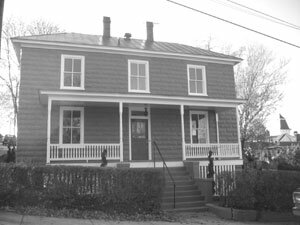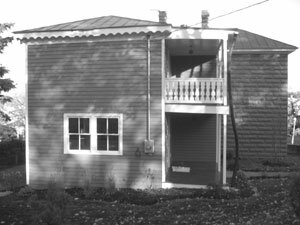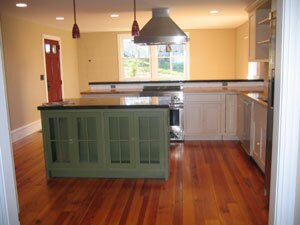Done up: Total restoration wins prize
ADDRESS: 118 Prospect Street, Staunton
NEIGHBORHOOD: Stuart Addition Historic District
ASKING: $439,000
CITY ASSESSMENT: $122,000
YEAR BUILT: 1845, 1904
SIZE: 2400 fin. sq. ft., 800 unfin.
LAND: 0.14 acres
CURB APPEAL: 8 out of 10
LISTED BY: Circa 1700 Builders Inc., 540-337-7514
People who respect old houses and want to see them restored to their former glory– with no cost-cutting or short-cuts, only authentic materials and careful attention to details– will understand the actions of the owners of this house in Staunton.
The couple who tackled this project– Connecticut natives who did this sort of meticulous restoration there before moving to Virginia last year– found themselves consumed by the past glory and the potential of the place. The result of their passion will appeal to a buyer who shares their sensibilities.
The original 1845 house consisted of four rooms and a porch. A 1904 addition added more rooms, and at some point after that, the place was converted to an over-and-under duplex– but in the most rudimentary way. Fortunately, very little was destroyed in the additions and conversions, so that when restoration began, there was a lot to work with.
Preserving as much as possible became a priority. For example, where less fastidious renovators might have restored the one-inch-thick random-width heart-pine flooring in place, these owners pulled up every plank to be re-milled and refinished. The result is some of the most beautiful flooring we've seen in any house. In the front hall, the wood has been finished in a "harlequin" pattern featuring dark-stained diamonds, which may be an exception to the "only original" commitment, but who knows? It's not impossible that the 1845 occupants had similar decorative touches in the house.
Other salvaged elements are all the original trim, a claw-foot tub in a bathroom, two mirror-topped mantels in the living room and study (or dining room), two-over-two double-hung windows, thick two-panel yellow-pine doors, and the concrete block facade sculpted to mimic chiseled limestone.
New features chosen to complement the original are an unusual hammered copper sink with tin tile backsplash and oiled bronze fixtures in the kitchen, art glass shades over the new island, and odd push-button light switches that look old but which include a dimmer button. New rooms were made from enclosing the two-story porch: a mudroom and half bath downstairs and a cork-floored laundry room upstairs.
But even the most careful restorers have to bow a little before modern demands. A wall was removed between the living room and kitchen to provide smooth flow between the rooms and a view straight from the front of the house to the back. In the kitchen, a concrete counter tops the island; all other counters are butcher-block. Hardwood maple cabinets with self-closing mechanisms look like they would make meal preparation a snap, as do the commercial-grade GE appliances.
Upstairs, the three bedrooms have carpet rather than hardwood floors, a disappointment in an old house. We expect that in new construction, but here it jars– although people stepping out of bed on cold mornings probably will care less than we do. And speaking of cold mornings, the house has dual heat sources: a heat pump for the second level and forced hot air fueled by a gas furnace downstairs. There's also a gas fireplace (alas) in the living room.
New porches have bead-board ceilings, cherry-stained wood floors, and the original railings. The inside staircase is also authentic (it was preserved in the duplex conversion)– a local woodworker copied the original balusters for the needed replacements. Upstairs fireplaces were removed to make room for closets (the chimneys are bricked up except for the gas-log flue), and those closets have neat little frame-mounted gizmos that turn the lights on automatically when the door is opened.
The neighborhood is an added benefit. The house is within sight of Mary Baldwin College, which has bought many of the houses across the street for college business. Next door is a re-do by a local architect, and downtown Staunton is within easy walking distance.
The yard– which is actually a lot and a half, with an old garage– is nice enough, considering the owners have chosen to direct their formidable talents to the restoration of the house rather than to landscaping. Foundation plantings, a few big trees, and a pretty new picket-ish fence keep it from being completely nondescript.
The Historic Staunton Foundation recently honored the house with its "total residential restoration" award, which should impress any buyers who need something official to cinch the deal. And prospective buyers who worry that the American Shakespeare Theater, the restoration of the old Visulite Theater and the Stonewall Jackson Hotel are not enough to lure them over the mountain will be interested to know that the people who redid this house are on their way to opening a hip new restaurant in the middle of town.
What more incentive does anyone need?


 PHOTOS BY ROSALIND WARFIELD-BROWN
PHOTOS BY ROSALIND WARFIELD-BROWN